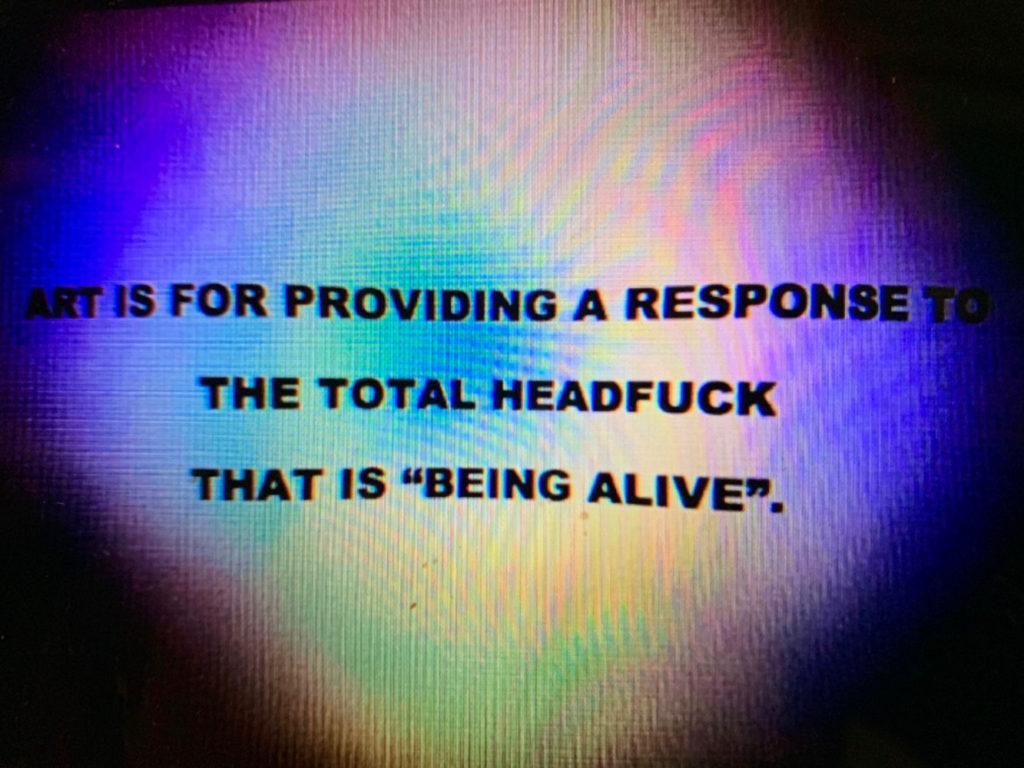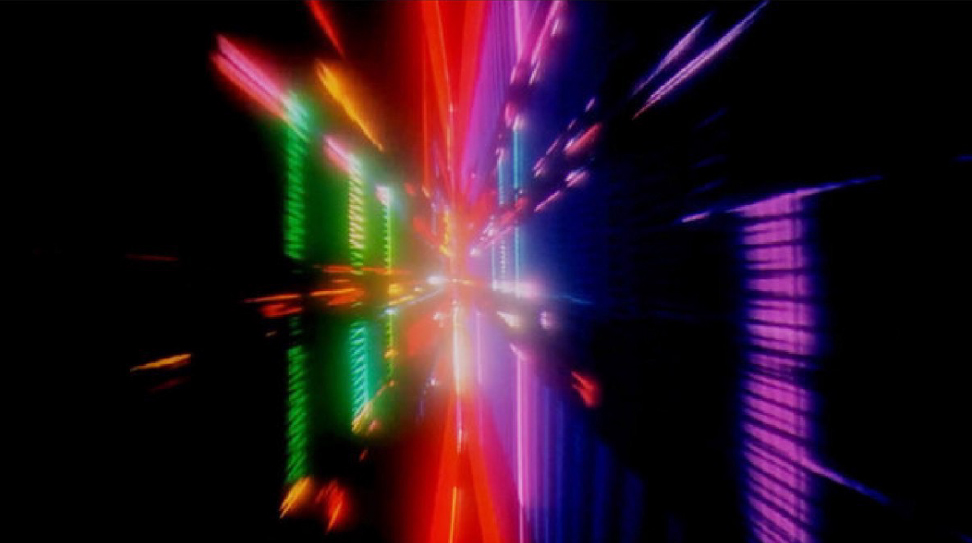Study Statement 1.0
TITLE
Finding the Digital/Analogue Infrathin
AIMS AND OBJECTIVES
There is a border between the digital world and real world. Using Duchamp’s idea of the infrathin, time-based media, viewing through the lens of metamodern sensibility and using metamodern methods, I would like to explore this border, capture it and define it.
When you take an image from the digital world into the real world and put it back into the digital world, there is a degradation. When you continue to bounce the image back and forth through the real and digital worlds, like with Alvin Lucier’s audio piece ‘I Am Sitting In A Room’ (Joseph, 2015), there are resonances that start to appear. Colours lose their subtlety and complexity and are reduced to primary and secondary RGB colours; patterns in the screen (depending on the screen used) start to moiré.
When we jump between the online and real worlds, is there a similar degradation that happens to us? Do we start to lose the full spectrum of ourselves? Do we get reduced, distilled, focussed into our primary and secondary components? Do we retain digital artifacts in our real lives? Can the virtual world be another other than the Almost World (Mahindra Humanities Center, 2021, 16m24s)?
AIM 1 Research ideas about immersion, fantasy/reality, real/unreal, alienation, screens, metamodernism in philosophy, critical theory, screen studies, cultural theory, film, literature, web culture.
Objective – Identify relevant texts and films that explore idea of the real/unreal.
Objective – Understand others’ ideas about travelling between the real/unreal.
Objective – Find and collect examples of individuals living within the divide between worlds
AIM 2 Start by making short films that explore, capture and define the digital/analogue infrathin and our changing understanding of what it means to ‘be human’ while existing in both physical and non-physical worlds. Work towards a longer final film.
Objective – Experiment with in-camera video techniques to visualise the infrathin
Objective – Consider whether the film needs narrative, if so write it.
Objective– Film and edit short films
AIM 3 Write an essay (?) that sets out the theory, history, context of this space.
Objective – Build on my knowledge and understanding of this space and metamodern methods and theory.
Objective – Visually study films that explore the divide between real and ‘unreal’ worlds.
Objective– Decide how ‘experimental’ the writing will be
Objective – Decide how/where the work will be published.
CONTEXT
The so-called ‘Stargate’ sequence in Stanley Kubrick’s 2001: A Space Odyssey (1968) is one of the most well-known visualisations of travelling between two worlds. The film’s theme is about how humans evolved physically by first taking conceptual leaps prompted by the presence of a ‘monolith’ which had been purposely planted for photo-humans and humans to find.
The journey through the ‘Stargate’ is a 10 minute sequence towards the end of the film and shows the character Dr. David Bowman undergoing sometimes violent and terrifying ‘transport’ from our solar system into another- alien- space. Bowman ends up in a kind of hotel created by alien beings. Here he lives out the rest of his life before he is transformed, evolved, into a new type of being, a ‘Starchild’. We don’t know how time progresses at his destination or if it progresses or if we are simply viewing an interpretation of a somatic hyper-evolutionary leap. It could be a representation of the journey between Now and a Conceptual Next.
The contact between Now and a Conceptual Next produces a third infrathin dimension (Loewen, 2019). The journey from here to there (whatever there is) is infrathin. It is portrayed as a space, another dimension, though whether it is physical or non-physical is unknown.
This journey can be interpreted as a physical journey- from here to there, from birth to death (to birth again?), from our world to the alien world- and also as a conceptual journey- from Us to NewUs, from the physical world to the non-physical- both via infrathin. We are shown the experience of what it is to see the unseeable, to make real the undefinable. To “[make] felt how both worlds might briefly coexist.” (Manning, 2016)
I am particularly keen on the metamodern filmmakers Charlie Kaufman, Michel Gondry, Wes Anderson. Kaufman for his philosophy (LaRocca, 2011), Gondry for his inventive mise en scene and Wes Anderson for his use of colour and his genius framing. It is highly unlikely any obvious influence from any of them will be in my final film.
I’m perhaps overly obsessed with avant garde filmmaker Peter Tscherkassky (Index Edition, 2019). I have been trying to work out a filming technique to use with digital video based on his technique with film stock. He has built himself a film holder onto which he places down one metre of unexposed, black and white filmstock and over the top of that he lays exposed and developed film – found footage, usually Hollywood films. He then shines a small laser over each individual frame, exposing only random parts of the unexposed film. It is this random exposure that I am interested in. It shows only a part of the image – we don’t get ‘the full picture’ – and some areas of the shot are never exposed at all.
Timotheus Vermeulen and Robin van den Akker’s work on Metamodernism (Vermeulen and van den Akker, 2010) is important and always on my mind. Greg Dember and Linda Ceriello’s work at What Is Metamodern (Dember and Ceriello, 2022) is also a great guiding light. I want my work to remain within a metamodern sensibility, oscillating between modernism and postmodernism.
I might have to invent metamodern avant garde filmmaking.
Laurie Anderson’s storytelling is important to me.
METHODOLOGY
I am trying to formulate my ideas into a cohesive narrative. I have too much to say. Every day I think of focussing on a different aspect of what I’m looking at. Sometimes I think I want to tell a big ‘story’, sometimes a very small one. No matter what, I want to make people think…
Theory – adding to my bibliography- books and journals/websites/web videos/etc that have been useful and informative, even if it’s just one sentence or one bit of information.
Collecting films – adding to my film bibliography
Research – I have been watching and reading about filmmakers who use experimental, in-camera or physical techniques (rather than digital effects).
Experimenting– Based on the work of experimental filmmakers such as Peter Tscherkassky, Douglas Trumbull, John Whitney and Vicky Smith -the final three can be seen at Handmade Cinema (Zinman, 2022) , I have been thinking up different techniques and trying them out. The filmmakers I mentioned worked with film. I necessarily want to work with digital video, but use in-camera techniques.
Organising– I have been trying to collect links on my blog – things I’ve read/watched, as well as things to read/watch. They will remain on my links page unless there is something I take out of them as a reference. Adding links to my blog doesn’t work well, however, if I’m on my phone or, for whatever reason, I am unable to log into my blog. I therefore haven’t always been successful at saving links on my blog. Instead, I have either bookmarked places on my browsers or have emailed them to myself. This is simply too disorganised to be useful. I’ve downloaded two different bookmarking apps that were recommended by a friend: MyMind and Raindrop.io I am hoping that these help with the organisation of online resources.
OUTCOMES
I’d like to make an experimental film about the real/digital infrathin. I tend to think my films are the work themselves, so – at this point – do not expect to want to include the film as part of an installation. I may change my mind about this.
I am thinking of also doing a book alongside the film which would include writing and images about the infrathin. I have not yet thought about whether or not this will be handmade or printed and how many copies I might produce…
WORK PLAN
Term 1
Start up my blog, use it to ‘collect’ information, images, reflective writing.
Read relevant books/texts/journals
Watch relevant films
Experiment with video techniques specifically using a computer and iPhone.
Term 2
Continue experimenting with techniques
Start writing short pieces- mini ‘essays’- to organise thoughts
Start to think of ‘the story’ I want to tell
Produce a short film (1-2 minutes) for the Interim Show.
Term 3
Continue writing short pieces to organise thoughts
Start to organise short pieces into a longer ‘thesis’
Continue experimenting with techniques – honing down ideas, what works, what doesn’t.
Decide on the ‘story’ to tell…
Summer
Reassess everything I have been doing before planning my final year. Decide what is working and what isn’t.
Term 4
Write final piece
Decide what form this will take – a book? Will it be handmade or printed?
Start filming elements for final film.
Term 5
Complete writing
Continue filming elements for final film
Edit sequences
Start working on audio
Term 6
Edit film
Finish audio
BIBLIOGRAPHY
Books https://www.giagia.co.uk/2021/10/01/bibliography-books/
Films/tv https://www.giagia.co.uk/2021/10/01/bibliography-films-tv/
Websites/Journals/Web videos/Etc https://www.giagia.co.uk/2021/10/05/bibliography-everything-else/
References
Dember, G. and Ceriello, L., 2022. [online] What Is Metamodern?. Available at: https://whatismetamodern.com/ [Accessed 13 February 2022].
Index Edition, 2019. Peter Tscherkassky – Outer Space. Available at: https://www.youtube.com/watch?v=GxQ3PucXg8k [Accessed 13 February 2022].
Joseph, M., 2015. MoMA | Collecting Alvin Lucier’s I Am Sitting in a Room. [online] Moma.org. Available at: https://www.moma.org/explore/inside_out/2015/01/20/collecting-alvin-luciers-i-am-sitting-in-a-room/ [Accessed 13 February 2022].
LaRocca (ed.), D., 2011. The Philosophy of Charlie Kaufman. [Kindle] Lexington, Kentucky: The University Press of Kentucky.
Loewen, R. (2019). INFRATHIN Project — Rebecca Loewen. [online] Rebecca Loewen. Available at: http://rebeccaloewen.com/inframince [Accessed 3 Feb. 2022].
Mahindra Humanities Center, 2021. Norton Lecture 2: The Forest | Laurie Anderson: Spending the War Without You Available at: https://youtu.be/v6UJjYkerJY [Accessed 5 February 2022].
Manning, E. (2016). For a Pragmatics of the Useless, or the Value of the Infrathin. Political Theory, 45(1), pp.97-115.
Tye, M. and Zalta (ed.), E., 2021. Qualia (Stanford Encyclopedia of Philosophy/Fall 2021 Edition). [online] Plato.stanford.edu. Available at: https://plato.stanford.edu/archives/fall2021/entries/qualia/. [Accessed 5 February 2022].
Vermeulen, T. and van den Akker, R. (2010). Notes on metamodernism. Journal of
Aesthetics & Culture, 2(1), DOI: 10.3402/jac.v2i0.5677
Van den Akker, R., Gibbons, A. and Vermeulen, T. (2017). Metamodernism. London:
Rowman & Littlefield International.
Zinman, G., 2022. Handmade Cinema – A Guide to the People, Practices and Themes of Artisanal Moving Image Production. [online] Handmade Cinema. Available at: https://handmadecinema.com/ [Accessed 5 February 2022].
2001: A Space Odyssey. (1968). [film] Directed by S. Kubrick. Shepperton Studios, Shepperton, England: Metro-Goldwyn-Mayer.

